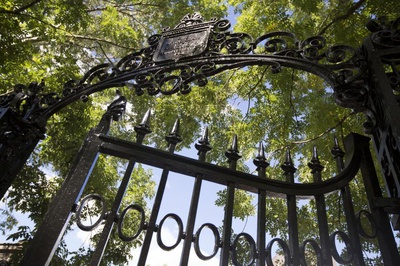
News
News Flash: Memory Shop and Anime Zakka to Open in Harvard Square

News
Harvard Researchers Develop AI-Driven Framework To Study Social Interactions, A Step Forward for Autism Research

News
Harvard Innovation Labs Announces 25 President’s Innovation Challenge Finalists

News
Graduate Student Council To Vote on Meeting Attendance Policy

News
Pop Hits and Politics: At Yardfest, Students Dance to Bedingfield and a Student Band Condemns Trump
Hitchcock’s Title of “Master of Suspense” Lives On

Whether “The Birds” left you with an irrational fear of all avian creatures or “Rear Window” had you questioning the sanity of your neighbors, it’s undeniable that British filmmaker Alfred Hitchcock left a lasting impact on the thriller genre. From his use of shock and tension that remains almost unrivaled to the dark topics he explores throughout his work, Hitchcock is well deserving of the title “Master of Suspense.”
The acclaimed director, well-known for his macabre style, initially gained fame in Britain before breaking into Hollywood. Born and raised in the East End of London — the old stomping grounds of serial killer Jack the Ripper — Hitchcock’s early years fittingly tie into what is widely regarded as his first “true” work, “The Lodger: A Story of the London Fog.” A silent thriller released in 1927, “The Lodger” follows a Jack the Ripper-esque murderer, perfectly setting the stage for the trajectory of Hitchcock’s career and talent for building suspense.
Hitchcock’s origins as a silent film director provided a foundation in the art of non-verbal communication. Throughout his early years, he quickly became a master of utilizing visually striking cinematography, emotive direction, and musical scores to create suspense and strike fear in audiences. After the British director switched away from silent films, these tendencies remained, ultimately allowing Hitchcock’s films to achieve a depth that had rarely been seen before that point.
Having made a name for himself in Britain, Hitchcock then released “The Man Who Knew Too Much (1934),” the global audience’s first introduction to his prowess in the thriller genre. A compelling tale of murder and intrigue, the film — ultimately remade by Hitchcock in 1956 — showcased one of the famed director’s most iconic trait: A haunting soundtrack. With music performed by the London Symphony Orchestra and striking sound effects, both interpretations of “The Man Who Knew Too Much” come to life to truly impact the audience in a way that standalone visual effects simply would not be able to achieve.
From “Psycho” and its infamous shower scene to the overall musical score of “North by Northwest,” sound design was an aspect of Hitchcock’s filmmaking that remained valued throughout his career. This attention to sound can completely alter a viewer’s perspective on a scene, and in this regard, Hitchcock’s work has inspired Hollywood’s increasing emphasis on musical composition.
Despite Hitchcock’s undeniable success across film genres, his ability to push the boundaries of the thriller genre has made him have one of the biggest and most long-lasting marks in the film industry.
Arguably the most iconic horror movie of all time, “Psycho” (1960) began an era of suspenseful story-telling that extends today. With the unpredictable plot-twist when the main character is brutally murdered, Hitchcock demonstrates his ability to shock his audience and subvert their expectations, now a gold standard for filmmakers in the eighty years since the film’s creation. By going against the tone and plot of the film up until that point, Hitchcock was able to masterfully break the unspoken trust between directors and audience members that had remained — for the most part — intact since the dawn of film.
Transitioning starkly from the standard set of thriller “guidelines” that had been implemented for filmmakers — where protagonists are expected to survive and guide the audience to a satisfactory conclusion — the remainder of “Psycho” is an uneasy deep-dive into the psyche of a killer. With the audience left reeling after the death of Janet Leigh’s Marion Crane, a figure of security and reassurance, a true thriller ensues.
This same sense of continuous discomfort is attempted in many ways through later thriller classics, including the works of American film director David Fincher, who has notably been heavily inspired by Hitchcock’s thrillers throughout the years. Fincher’s 1995 crime thriller “Se7en” adopts a similar source of suspense as “Psycho” by creating a psychologically tormented killer who is ever present throughout the plot but withheld from the audience until the end. Similarly, director Rob Reiner’s “Misery” (1990) starring Kathy Bates — yet another famous Bates — incorporates Hitchcock throughout by choosing to deeply examine the psyche of the antagonist rather than distract the viewer with gore and fast-paced action.
Revolutionizing so many aspects of thrillers that he practically created his own genre, Hitchcock made a mark that is no way limited to the conceptual. From a technical standpoint, the English director fathered the dolly zoom or “zolly” — a camera technique that keeps the subject in proportion with the frame while the backdrop changes size and depth. The “zolly” was used by Hitchcock and subsequent thriller directors to typically indicate a revelation or dramatize a distance. “Vertigo” was one of Hitchcock’s first films to utilize this technique, elevating the film by visually representing the protagonist’s fear of heights, a central plot point. Fellow filmmaking giant Stephen Speilberg has utilized this camera technique in various projects, including in his shark-centered thriller “Jaws” (1975) to indicate a moment of realization.
With recent blockbuster hits such as “Saltburn” (2023) taking pointers from Hitchcock’s knack for suspense and rumors of a David Fincher remake of “The Rope,” the treasured director and his influences are in no way an artifact of the past. Still ever-present in modern Hollywood, both within and outside of the thriller genre, it is unlikely that the Hitchcockian thrillers and the qualities that define them — striking direction, thoughtful musical score, and jarring psychological depth — will be going anywhere soon.
Want to keep up with breaking news? Subscribe to our email newsletter.
From Our Advertisers

Over 300+ courses at prestigious colleges and universities in the US and UK are at your disposal.

Where you should have gotten your protein since 1998.

Serve as a proctor for Harvard Summer School (HSS) students, either in the Secondary School Program (SSP), General Program (GP), or Pre-College Program.

With an increasingly competitive Law School admissions process, it's important to understand what makes an applicant stand out.

Welcome to your one-stop gifting destination for men and women—it's like your neighborhood holiday shop, but way cooler.

HUSL seeks to create and empower a community of students who are seeking pathways into the Sports Business Industry.
